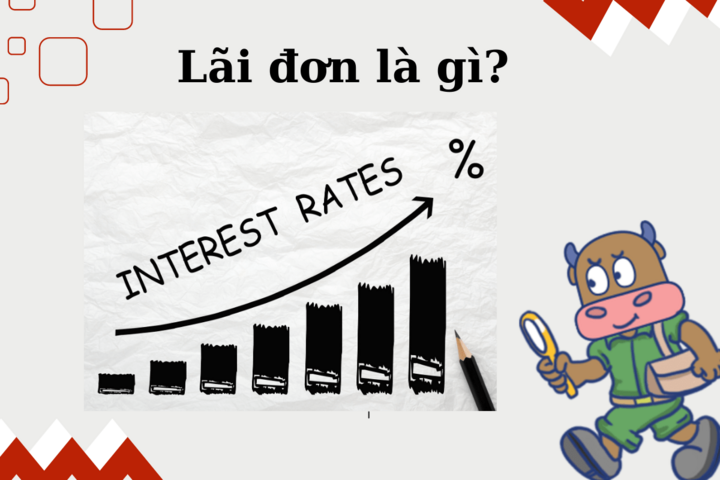As a rule, simple interest is usually determined based on three factors: the initial principal; the interest rate applied to the interest calculation period and the number of interest calculation periods.
For example: You borrow 10 million VND from the bank with an interest rate of 3%/month, the interest you have to pay in the first month is 10,000,000 * 3% = 300,000 VND. The following month, the interest is still calculated as 300,000 VND.
Thus, each month, the interest is always calculated based on the initial principal amount of 10 million VND, provided that you pay the loan on time, the interest amount will not change.
Benefits of simple interest
Simple interest not only helps individuals and businesses manage their finances easily, but also stimulates borrowing and investment, contributing to national economic development. The transparency and stability of simple interest help create a trustworthy financial environment.
For people: Simple interest helps people easily calculate and control the amount of interest they have to pay, making borrowing simpler. This encourages people to borrow capital for investment and consumption.

Simple interest is interest calculated on the original principal without adding previously accumulated interest. (Source: Internet).
For businesses, the fixed interest payment helps businesses control risks and plan long-term finances. This is especially important for startups to be able to focus on business development without worrying about the complexity of compound interest. In addition, simple interest also helps businesses easily access loans, have more money to invest in new projects and expand the business scale.
The stability of simple interest encourages people to save when they have spare money instead of spending lavishly or investing in risky assets. This reduces consumer demand and inflationary pressure.
At the same time, the stability of simple interest helps investors tend to invest in long-term assets, production projects and infrastructure. Thereby increasing the supply of goods and services. The increase in supply can reduce the price of goods, contributing significantly to preventing inflation.
Formula for calculating simple interest
Simple interest is calculated based on the following formula:
Simple interest = A*n*r /100
In there:
A: The initial amount of money deposited for investment or loan.
n: Number of interest periods, usually calculated in years.
r (%): Applicable interest rate.
Specific examples:
You deposit 50 million VND in the bank for a 2-year term, with an interest rate of 6% per year. Based on the formula for calculating simple interest, we have:
Simple interest = 50,000,000 *6*2/100 = 6,000,000 VND.
Thus, after 2 years of saving with simple interest, you will receive the principal and interest of 56 million VND (an increase of 12%).
Advantages and disadvantages of simple interest
About the advantages:
The amount of interest to be paid when borrowing is not too much when applying simple interest. Because the interest is calculated only based on the initial capital, not accumulated from previous periods.
For short-term borrowers or those who borrow small amounts of money, simple interest can help them save a significant amount of money.
The interest calculation method is simple and easy to understand, suitable for everyone, especially those who are new to borrowing or investing.
Debts will be paid easily and on time thanks to the transparency and clarity of simple interest.
About the disadvantages:
Does not reflect the true cost of finance: Simple interest only calculates interest on the original principal without taking into account the interest that has accrued. Therefore, it does not truly reflect the actual amount of interest on a loan or investment compared to compound interest. This can lead to underestimating the cost of borrowing and making incorrect choices.
Lack of flexibility in the face of market fluctuations: When market interest rates fall, borrowers using simple interest cannot take advantage of lower interest rates. In contrast, with compound interest, interest rates can be adjusted to reflect current interest rates, helping borrowers save and optimize financial costs.
Not optimizing interest for long-term or large-amount loans: Some cases show that applying simple interest does not provide optimal benefits compared to taking advantage of other interest calculation methods, especially for large or long-term loans.
Applications of simple interest in practice
In practice, simple interest is often applied to a few specific cases as follows:
Personal Loans: In personal loans, simple interest is used to calculate interest rates simply and quickly. This makes it easy for both parties to track and manage the amount of interest payable. In addition, borrowing costs are also minimized by taking advantage of simple interest.
Short-term loans: Simple interest is also used for short-term loans, such as cash loans for purchases or consumption. These loans need to be repaid quickly, so applying simple interest simplifies the interest calculation process and provides a more stable return than compound interest.
Source: https://vtcnews.vn/lai-don-la-gi-ar913036.html


![[Photo] Vietnamese rescue team shares the loss with people in Myanmar earthquake area](https://vstatic.vietnam.vn/vietnam/resource/IMAGE/2025/4/6/ae4b9ffa12e14861b77db38293ba1c1d)
![[Photo] Military doctors in the epicenter of Myanmar](https://vstatic.vietnam.vn/vietnam/resource/IMAGE/2025/4/6/fccc76d89b12455c86e813ae7564a0af)
![[Photo] Prime Minister Pham Minh Chinh chairs the regular Government meeting in March](https://vstatic.vietnam.vn/vietnam/resource/IMAGE/2025/4/6/8393ea0517b54f6791237802fe46343b)


![[Photo] Solemn Hung King's Death Anniversary in France](https://vstatic.vietnam.vn/vietnam/resource/IMAGE/2025/4/6/786a6458bc274de5abe24c2ea3587979)



















































































Comment (0)